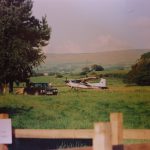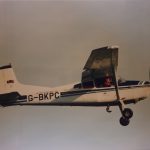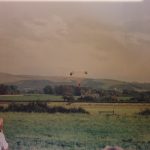Wow: a most memorable weekend. As you’ll remember, I spent the last weekend on a crash-course in parachuting in Lancashire. Having spent plenty of time in light aircraft or coasting around in a paraglider, I thought I had it sized: but it turned out to be even more spectacular (and scary) than I could have possibly predicted.
Saturday consisted of an exhausting seven hours or so of training: standing around in a field, doing such activities as demonstrating that we can arch our backs into the “stable position” and shouting “One thousand, two thousand, three thousand… check canopy!”, only to have some instructor shout “Malfunction!” and therefore have to go through our emergency process (“Look, locate, peel, pull, punch, arch!”) for the seventy-somethingth time… or lying on our bellies on overgrown skateboards, wiggling our bodies into strange contortions in order to simulate airflow (somewhat reminiscent of the idea of learning to swim by lying on a bench and practising strokes – little real value)… or clambering into a mock-up wooden aircraft (imagination required), climbing out onto the wing, and preparing to jump… or hanging in suspended harnesses, fumbling with the controls of make-believe parachutes…
I made my first jump on Saturday, early in the evening. Despite having been cool as a cucumber for the entire training process, I was very apprehensive by now. But this apprehension drifted gently away to be replaced with blind panic the moment we’d spiralled up to 3500 feet and the instructor opened the door, filling our faces with a 50mph wind. The plane was a small four-seater single-screw affair, with all but the pilot’s seat surgically removed so as to squeeze five parachutists (four students and an instructor, in this case) at a time into it, kneeling down and getting pins and needles in their feet. The instructor tapped the pilot on the shoulder: “Cut,” he shouted, and the pilot obliged, cutting engine power to a fraction and causing the plane to lurch downwards in a stomach-gulping manner. Before I knew it, it was my turn to jump.
“Feet out!” shouted the instructor, unsympathetically, slapping my on the shoulder and making a last check of my static line (the device that automatically deploys your parachute – essentially a long nylon strap attaching your ripcord to the pilot’s seat). I knew the drill by heart, having practised it to death on the ground: I grasped each side of the aeroplane’s door and put my right foot out onto the step. Then, that secure (considering the head wind), I reached out with my left hand and held the wing support beam. Then my right hand. Then, finally, I moved my left foot out and precariously swapped it with my right, leaving my right dangling above a 3500 foot hole. I couldn’t help but look down, and see fields stretching out, little cars moving along the roads, and occasional stray clouds meandering by. I looked back into the plane to signify my readiness…
“Go!” shouted the instructor. I let go.
At that moment, I forgot everything that I had spent so long learning. For some time to come, I was unable to remember the four seconds that followed. I was later to learn (and, later still, to remember) that I let go gracefully, but then – instead of forming the stable ‘arch’ position (important, as it keeps your back facing ‘up’, allowing your parachute to deploy correctly) – I put my hands by my sides, causing me to fall head-first until my ‘chute deployed. I remembered hanging onto the wing, and I remembered my parachute opening, but the rest was completely missing for the next half-hour.
During the three further jumps I performed on Sunday, there was no trace of the fear that had gripped me during the initial phases of my first: and, in fact, I was able to get the hang of assuming the correct position and landing without crippling myself… moreover, I’m now qualified to a level at which I’m permitted to begin DRCP (Dummy Rip-Cord Pull) jumps, in which I would leap from a plane and pull what is effectively a glorified handkerchief from the back of my backpack, symbolising the correct pulling of a rip-cord. Doing this will eventually allow me to do a free-fall, and is a progressive stage towards certification as a skydiver. Which is nice.
I loved it. Everybody in a fit state should do this sometime. Wonderful.













And strangely, on the plane to Dublin today, one moment gave me an adrenelin rush – after the 737 had climbed, and reduced power. Something inside went ‘bing’ and I was immediately ready to climb out on to the wing! Didnt though!
Jumper in the Air,
You have a Malfunction!
Feet and Knees together and Pull your Reserve Ripcord!
Enjoyed the article immensely. Especially the part about forgetting everything you learned during training during your first jump. That’s exactly my experience during my first parachute jump at Army airborne school at Ft. Benning, Ga. Forgot everything: the counting for the reserve chute, keeping my legs together, etc, etc. But, just as in the article, remembered everything in all subsequent jumps. That was over 58 years ago for me. Great article. Brought back so many memories. Charles